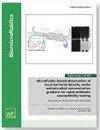pH effects on capture efficiency and deposition patterns in sessile droplet immunoassays: An XDLVO analysis
IF 2.4
4区 工程技术
Q2 BIOCHEMICAL RESEARCH METHODS
引用次数: 0
Abstract
Immunosensors are crucial for various applications, with capture efficiency and detection time as key performance parameters. Sessile droplets on functionalized substrates have demonstrated potential as micro-reactors for antibody–antigen binding, reducing detection time and analyte volume due to the presence of convective currents. Tuning the surface charges by adjusting buffer pH can modulate antigen capture efficiency. While the impact of pH has been studied on antibody–antigen binding in flow and non-flow systems, the use of sessile droplets and the specific impact of buffer pH on the capture efficiency of surface-functionalized antibodies remains understudied. Understanding how pH affects capture and deposition patterns is vital for optimizing immunosensor design. Additionally, the mechanisms governing internal flow within the droplet and dominant driving forces require further investigation. We investigated the effect of varying buffer pH on prostate-specific antigen (PSA) capture by anti-PSA functionalized polydimethylsiloxane substrates. Capture efficiency was measured using the Brown–Anson model applied to cyclic voltammetry, validated with electrochemical impedance spectroscopy. pH significantly influenced PSA capture by surface-immobilized anti-PSA IgG. The extended Derjaguin–Landau–Verwey–Overbeek theory explained the interplay between pH and internal flow. Micro-particle image velocimetry (PIV) confirmed internal flow, primarily driven by Marangoni flow from solute concentration gradients. Controlling buffer pH in biosensors offers higher capture efficiency and desired deposition patterns. These insights advance immunosensor design and hold potential for biomedical and diagnostic applications.pH 对无柄液滴免疫测定中捕获效率和沉积模式的影响XDLVO 分析
免疫传感器对各种应用都至关重要,其关键性能参数是捕获效率和检测时间。功能化基底上的无水液滴已证明具有作为抗体-抗原结合微反应器的潜力,由于存在对流,可缩短检测时间并减少分析物体积。通过调节缓冲液的 pH 值来调整表面电荷可以调节抗原捕获效率。虽然人们已经研究了pH值对流动和非流动系统中抗体-抗原结合的影响,但对无柄液滴的使用以及缓冲液pH值对表面功能化抗体捕获效率的具体影响仍然研究不足。了解 pH 值如何影响捕获和沉积模式对于优化免疫传感器设计至关重要。此外,液滴内部的流动机制和主要驱动力也需要进一步研究。我们研究了不同缓冲液 pH 值对抗 PSA 功能化聚二甲基硅氧烷基底捕获前列腺特异性抗原(PSA)的影响。捕获效率采用布朗-安森模型进行循环伏安法测量,并通过电化学阻抗谱进行验证。 pH 值对表面固定的抗 PSA IgG 捕获 PSA 有显著影响。扩展的 Derjaguin-Landau-Verwey-Overbeek 理论解释了 pH 值与内部流动之间的相互作用。微粒子图像测速仪(PIV)证实了主要由溶质浓度梯度产生的马兰戈尼流驱动的内流。在生物传感器中控制缓冲液的 pH 值可提高捕获效率和理想的沉积模式。这些见解推动了免疫传感器的设计,并为生物医学和诊断应用带来了潜力。
本文章由计算机程序翻译,如有差异,请以英文原文为准。
求助全文
约1分钟内获得全文
求助全文
来源期刊

Biomicrofluidics
生物-纳米科技
CiteScore
5.80
自引率
3.10%
发文量
68
审稿时长
1.3 months
期刊介绍:
Biomicrofluidics (BMF) is an online-only journal published by AIP Publishing to rapidly disseminate research in fundamental physicochemical mechanisms associated with microfluidic and nanofluidic phenomena. BMF also publishes research in unique microfluidic and nanofluidic techniques for diagnostic, medical, biological, pharmaceutical, environmental, and chemical applications.
BMF offers quick publication, multimedia capability, and worldwide circulation among academic, national, and industrial laboratories. With a primary focus on high-quality original research articles, BMF also organizes special sections that help explain and define specific challenges unique to the interdisciplinary field of biomicrofluidics.
Microfluidic and nanofluidic actuation (electrokinetics, acoustofluidics, optofluidics, capillary)
Liquid Biopsy (microRNA profiling, circulating tumor cell isolation, exosome isolation, circulating tumor DNA quantification)
Cell sorting, manipulation, and transfection (di/electrophoresis, magnetic beads, optical traps, electroporation)
Molecular Separation and Concentration (isotachophoresis, concentration polarization, di/electrophoresis, magnetic beads, nanoparticles)
Cell culture and analysis(single cell assays, stimuli response, stem cell transfection)
Genomic and proteomic analysis (rapid gene sequencing, DNA/protein/carbohydrate arrays)
Biosensors (immuno-assay, nucleic acid fluorescent assay, colorimetric assay, enzyme amplification, plasmonic and Raman nano-reporter, molecular beacon, FRET, aptamer, nanopore, optical fibers)
Biophysical transport and characterization (DNA, single protein, ion channel and membrane dynamics, cell motility and communication mechanisms, electrophysiology, patch clamping). Etc...
 求助内容:
求助内容: 应助结果提醒方式:
应助结果提醒方式:


